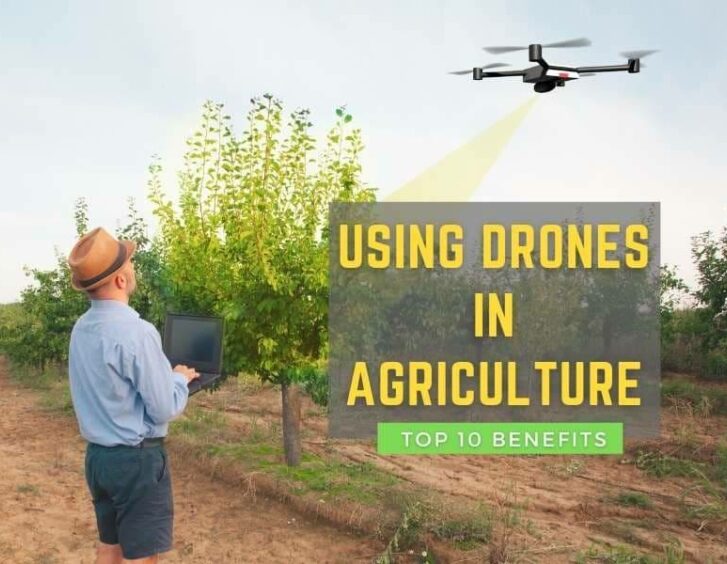This article provides a comprehensive guide to getting started with agriculture drone and discusses the benefits of using drones in agriculture.
Agriculture is one of the fastest-growing markets in the commercial drone industry today. When examining other industries and considering recent advancements in drone technology, it's not hard to see why: Drones are changing agriculture for the better!
Farmers can use drones to monitor plant growth on farmland, spray pesticides, and spread seeds to boost agricultural output.
Basic Elements Of Agriculture Drone
Frame
The Frame is the quad's X or plus-shaped Frame that holds all components and pieces together.
It might be a solid structure with immobile arms, landing gear, or a foldable design for easy transportation.
Motors
The motor is the system that drives the propellers. Brushes have been largely replaced by brushless motors, which are quieter and more powerful.
The motors might require cleaning from time to time to function effectively.
Electronic Speed Control (ESC)
The power is distributed through the D-box, which connects the battery to the motors and sends signals to each drone motor instructing it to control propeller speed. This is how the drone interprets the data provided by the controller.
The ESC is usually hidden beneath most drones' shells, although this may not always be the case.
Flight Control Board
Flight Board Control is the brain or computer of the drone, which converts electrical activity from the controller into actionable data by sending signals to the ESCs.
Radio Receiver
The drone receives the signal from the remote control with a radio receiver. It might be mounted on a pole or stick out of the bottom of the drone.
Propellers
The propellers are the spinning plastic blades at the end of each arm, used to generate lift and direct the drone's motion.
The propellers rotate independently to carry the aircraft in different directions.
As this is the most common component of a drone to break, your drone will usually include spares.
Battery
Depending on the drone model, the battery may be charged in either the drone or a separate charger.
If your drone has a detachable battery, it's a good idea to keep extras on hand so you can enjoy more flight time.
Gimbal
A camera drone will come with a camera and gimbal, which is the mechanism that keeps the camera steady while it's airborne.
The gimbal is a device that keeps the camera stable in the air. The gimbal may be controlled by buttons to change the shot angle depending on the drone.
Getting familiar with the controller
Drones are often used in agriculture to take aerial shots. One way that agriculture drones can be controlled is through remote control.
The controller sends signals to the drone's flight board, telling how much power should be distributed through each propeller to fly in different directions or maintain altitude.
The radio receiver receives the signal from the remote control and translates it for ESCs to know when to speed up or slow down their motors accordingly.
Drones have both manual and automatic modes, depending on preference - but whichever model you choose, using your remote will lead to better footage of your crops!
For a standard controller configuration, there are left and right stick controls:
The left stick controls - Up and down movement (throttle): The height or altitude of the drone is controlled by this knob.
The pivot action (yaw) - Pivot refers to the drone turning in and facing a new direction.
The right stick controls - Left/right movement (roll): The left and right movement of the drone may be controlled with this knob.
Forward/back movement (pitch) - The forward and backward movement of the drone is controlled by this knob.
Some other features that are unique to different drone models include:
RTH (Return To Home) – If you have a GPS drone, this is the button that will bring it back to earth. It may be pushed to send the aircraft back to ground level within a few feet of where it took off.
Camera shutter button – If you have a camera drone, the controller will feature a shutter button or start and stop video recording.
Flight modes – If your drone has various modes, a button on the controller often allows you to change between them rapidly.
Smartphone holder – Camera drones for photographers typically do not have a screen on the controller but instead use a smartphone or tablet to view the camera pictures and operate many flight and camera features.
Depending on your controller's design, your smartphone may be positioned above or below.
Summary of FAA Rules & Regulations
Here is the summary of the FAA Rules & Regulations:
You must register your drone if it weighs over 0.55 lbs (250g).
Your registration label number must be visible outside your drone, and you must carry proof of registration when flying your drone.
- If your drone weighs more than 0.55 lbs, you must register it with the FAA.
- Your drone must not fly any higher than 400 feet above ground level.
- Don't fly your drone in controlled airspace
- Keep out of the path of any manned aircraft.
- Keep your drone in sight at all times.
- Don't fly at night.
- Don't fly over a moving car or person.
- Stay out of the way of first responders.
- Don't fly while intoxicated.
- You might also need a knowledge and safety test to get your license.
Getting Ready Checklist
- Charge your drone and controller.
- Download the flight app to your smartphone from the App Store or Google Play.
- Create an account to log in to the app and check for firmware updates.
- Connect your smartphone with a controller and drone
- Perform firmware updates for both the drone and controller if detected.
- Verify system settings and status
- Format SD batteries card to free up disk space
Pre-flight Checklist
- Check weather forecast
- Select and research flight location (Google Maps/Earth, B4UFLY app, etc.)
- Visually inspect aircraft for damage
- Remove lens cover/gimbal clamp
- Clean camera lens
- Confirm SD card in aircraft
- Check that props are on securely
- Check batteries are correct temperature and properly fitted
- Turn on the controller, then the aircraft
- Set max height to 400ft
- Set home point
- Set RTH height
- Check satellite connection and strength
- Perform compass calibration, if required
- Select desired flight mode
- Verify camera settings
- Set image storage location to SD card
- Check wind speed and weather conditions
- Double-check for obstacles (power lines, trees, buildings, etc.)
- Select take-off and landing point
- Take note of the backup landing area
Take-off Checklist
- Clear take-off zone
- Throttle forward to lift off or push the take-off button
- Hover at 7-10 feet for 15 seconds to check the stability
- Check all controls are responsive
Post-flight Checklist
- Check propellers for damage and fold
- Check the airframe for damage
- Remove (and backup) the SD card if required
- Replace the camera retainer and cover
- Remove aircraft battery
- Ensure all components are turned off
- Repack components and UAS
- Check site is clear
Why Use Agriculture Drone in Your Farms?
Now that we have basic knowledge about drones let's discuss the use of drones in agriculture.
Agriculture drones are an emerging technology. There are drones currently on the market designed specifically for agriculture that you can buy and implement. There is also a strong case for why agriculture drones will be incredibly useful and profitable once more people use them.
We've compiled a list of some of the most popular ways farmers use drones to enhance their operations and make informed judgments about their plants.

How to start organic farming? Download our complete guide on how to start organic farming.
Crop Scout to Detect Pests and Diseases
Crop scouting is the process of monitoring crop growth, condition, and yield. It's one of agriculture's most important practices, but it can be expensive to do on foot or by car. Agriculture drones are an emerging technology that has been designed specifically for agriculture. With agriculture drones, farmers now have an affordable way to keep up with changes in their fields from a bird's eye view.
They're also less time-consuming than traditional methods of crop scouting because they allow you to quickly scan large areas instead of walking through them at ground level. And if you're looking for potential problems like pests or diseases before they become more widespread, agriculture drones can help you spot trouble early on and respond accordingly.
Accurate plant counts
One of the most interesting applications for drone mapping in agriculture is doing comprehensive, precise plant counts. Farmers know that counting plant populations accurately can mean the difference between good and bad yields. In agriculture, the slightest error in population counts can dramatically impact yields.
Large fields have been difficult for farmers to count accurately because you need to get down into the area being counted, which is time-consuming and costly. With agriculture drones, farmers can now complete this task from the air. Aerial agriculture drone mapping allows growers to quickly and accurately determine the populations of their crops, which can be an invaluable tool for ensuring high yields.
Analyze stand establishment
Corn and soybean farmers employ drone mapping to inspect newly planted crops and determine whether certain areas need replanting.
Stand establishment is the process of ensuring that your crops take root and grow as you expect. It requires planting seeds in straight lines, at the right depth and spacing - which can be difficult to monitor from the ground.
With agriculture drone mapping technology, farmers can now monitor stand establishments by flying over recently planted fields and drawing a path for the agriculture drone to follow. As such, agriculture drones collect images from the air that can quickly reveal whether your plant stands are as well-placed as intended. If not, you can use agriculture drone mapping data to accurately monitor stand establishment and take necessary corrective action.
Generate Variable Rate Prescriptions for Nitrogen and Pesticides
Using agriculture drones to monitor conditions in your fields can help you generate rich data informing your decisions about variable rate prescriptions. Variable-rate prescriptions are agriculture applications where the amount of fertilizer or pesticide is based on specific characteristics of a particular field, including soil type, terrain, slope, drainage, and land use. Using agriculture drone mapping information allows farmers to accurately determine the right fertilizer and chemicals to apply in their fields.
The agriculture drone map can help you determine how much nitrogen should be applied for maximum yields while accounting for other factors like crop type, planting date, and variety. This information can then be fed into agriculture variable rate prescription software that customizes agriculture application rates based on each field's conditions.
Drone mapping agriculture in your fields can also help you avoid wasteful practices, like over-applying chemicals or fertilizers that could pollute the environment and cause harm to animals.
Assess and Clean-up Damage After a Storm
When a storm or other natural disaster damages a large agricultural area, farmers often don't have enough time to thoroughly inspect the damage before replanting and applying chemicals. But agriculture drone mapping lets growers capture data from the air in little time with agriculture drones so you can quickly assess agriculture damage and determine how best to move forward.
Negotiate Fair Crop Loss Percentages
As every grower knows, crop loss is always possible — and that's why many choose to insure their crops. But because insurance adjustors only have time to walk small sections of a damaged field, gaining an accurate picture of the loss can be difficult. Agriculture drones take agriculture drone mapping technology to the next level by providing agriculture insurance adjustors with detailed agriculture areas of losses within an agriculture field, making it easier to determine accurate loss rates.
Assess Slope and Drainage After the Harvest
Using a drone-generated elevation map can help us pinpoint areas that may have drainage problems in the future. Agriculture drones can also monitor farm equipment activity concerning slopes and drainage channels to prevent potential agriculture hazards. Making agriculture drone mapping part of your annual plan can help you identify concerns before they become issues, keep fields in optimal condition and prioritize agriculture safety.
Crop Dusting/Spraying
Agricultural drones also carry tanks of fertilizers and pesticides to spray crops. Drones like this can spray crops with far more precision than a traditional tractor. A drone can spray a field that is one acre in size with chemicals in about 7 minutes. This leaves more time for the farmer to tend to other agricultural activities, such as planting and harvesting. This agriculture practice also reduces pesticide runoff from happening because it is applied directly to the crops needed rather than spraying an entire area indiscriminately.
Detect Weed Infestations
Weeds are a serious agriculture problem that can crowd outcrops and reduce agriculture yields. Agriculture drones can map weed agriculture infestations to inform pre-seed practices like plowing and tilling. Mapping weeds across an agriculture field is also helpful when determining if herbicides are needed before planting.
Identifying Plant Stress
Plant stress caused by dry weather, insects, or disease causes agriculture production to drop. Agriculture drones can provide agriculture maps of agriculture fields in real-time to document when and where conditions are less than ideal. Drones with agriculture sensors collect data on a specific agriculture field's moisture levels, crop health, and more, so growers can quickly spot problems and respond accordingly before they cause permanent agriculture damage or loss.
Agriculture drones provide growers with real-time tools that can map agriculture fields, helping them determine when and where conditions are less than ideal. With a drone, you'll be able to spot problems before they become agricultural issues and help keep your field in optimal condition for the next round of planting or harvesting. As we continue to find innovative ways of increasing agricultural production without destroying natural resources or harming our environment, it's important to consider what needs doing now and how those decisions could impact future generations.
FAQs
How Can Agriculture Drones Benefit Indoor Vertical Gardens?
Agriculture drones can provide invaluable tips for indoor vertical garden maintenance. By utilizing drones to monitor plant health and water levels, gardeners can ensure optimal growing conditions. Drones can also aid in the efficient distribution of fertilizers and pesticides, maximizing the productivity of indoor vertical gardens.
How is drone used in agriculture?
In general, drones collect data on a farm or field, helping farmers better understand their growing conditions and make more informed decisions about crop management. Some common applications of drone technology in agriculture include monitoring crop health, assessing soil quality and moisture levels, surveying land, and identifying a potential pest or disease outbreaks. Drones can also apply inputs such as fertilizer or pesticides more precisely and efficiently, reducing the risk of over spraying while helping improve crop yields.

Learn the secrets of successful farming: Tips, techniques and strategies for a prosperous farm business
















